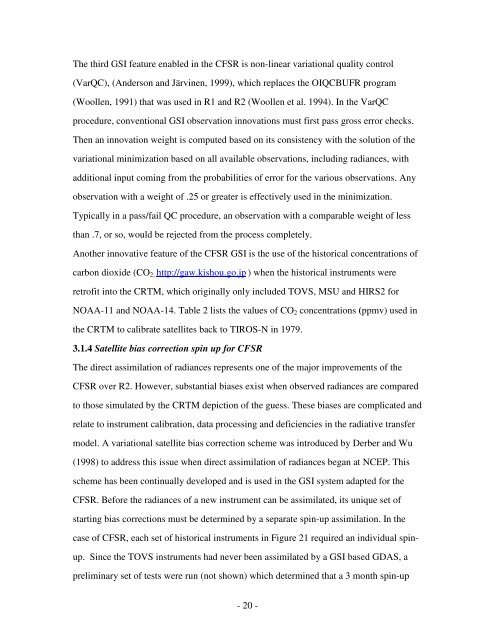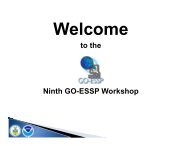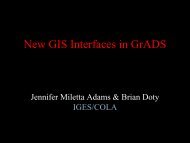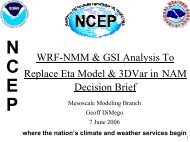The NCEP Climate Forecast System Reanalysis - NOAA National ...
The NCEP Climate Forecast System Reanalysis - NOAA National ...
The NCEP Climate Forecast System Reanalysis - NOAA National ...
You also want an ePaper? Increase the reach of your titles
YUMPU automatically turns print PDFs into web optimized ePapers that Google loves.
<strong>The</strong> third GSI feature enabled in the CFSR is non-linear variational quality control(VarQC), (Anderson and Järvinen, 1999), which replaces the OIQCBUFR program(Woollen, 1991) that was used in R1 and R2 (Woollen et al. 1994). In the VarQCprocedure, conventional GSI observation innovations must first pass gross error checks.<strong>The</strong>n an innovation weight is computed based on its consistency with the solution of thevariational minimization based on all available observations, including radiances, withadditional input coming from the probabilities of error for the various observations. Anyobservation with a weight of .25 or greater is effectively used in the minimization.Typically in a pass/fail QC procedure, an observation with a comparable weight of lessthan .7, or so, would be rejected from the process completely.Another innovative feature of the CFSR GSI is the use of the historical concentrations ofcarbon dioxide (CO 2, http://gaw.kishou.go.jp ) when the historical instruments wereretrofit into the CRTM, which originally only included TOVS, MSU and HIRS2 for<strong>NOAA</strong>-11 and <strong>NOAA</strong>-14. Table 2 lists the values of CO 2 concentrations (ppmv) used inthe CRTM to calibrate satellites back to TIROS-N in 1979.3.1.4 Satellite bias correction spin up for CFSR<strong>The</strong> direct assimilation of radiances represents one of the major improvements of theCFSR over R2. However, substantial biases exist when observed radiances are comparedto those simulated by the CRTM depiction of the guess. <strong>The</strong>se biases are complicated andrelate to instrument calibration, data processing and deficiencies in the radiative transfermodel. A variational satellite bias correction scheme was introduced by Derber and Wu(1998) to address this issue when direct assimilation of radiances began at <strong>NCEP</strong>. Thisscheme has been continually developed and is used in the GSI system adapted for theCFSR. Before the radiances of a new instrument can be assimilated, its unique set ofstarting bias corrections must be determined by a separate spin-up assimilation. In thecase of CFSR, each set of historical instruments in Figure 21 required an individual spinup.Since the TOVS instruments had never been assimilated by a GSI based GDAS, apreliminary set of tests were run (not shown) which determined that a 3 month spin-up- 20 -





